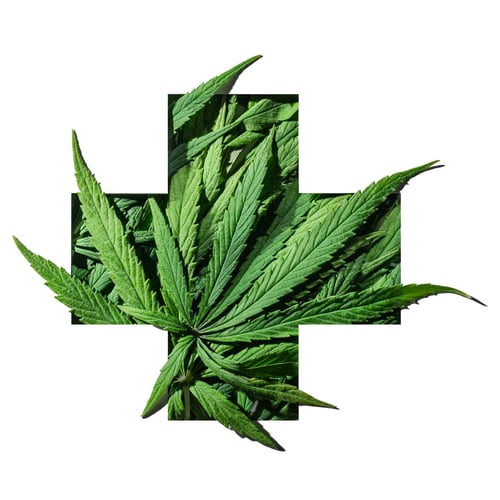
June 2023
The Hazy Future of Cannabis Liability
Table of Contents



Hashing Out the Details of Cannabis Liability
In this month’s issue, we will look at the intersection of cannabis and healthcare liability. With many states legalizing medicinal and/or recreational cannabis use while it is still criminalized at the federal level, the legal landscape is hazy for medical professionals.
There have been studies on the effectiveness of cannabis products on managing the symptoms of a variety of medical conditions—prompting patients to request more information, or even a prescription, from their physician. Even in states where this is legal and physicians feel comfortable blazing a new trail in alternative treatments, finding concrete information to go on can be difficult.
The FDA and CDC have both released some guidance on identifying and managing cannabis products within their respective jurisdictions. The Joint Commission has yet to release a formal statement specific to marijuana. And, with marijuana still classified as a Schedule I substance under the Controlled Substances Act, research opportunities are limited. This increases the difficulty for medical professionals’ attempting to learn how cannabis can be used in a medical setting and how cannabis interacts with other medications. There is also the concern that a recreational user may not be forthcoming about what is in their system—leading to unanticipated outcomes during a procedure or exam.
In spite of all this uncertainty, a majority of states have now legalized marijuana for some combination of medical and recreational use—two were formalized during the production of this issue. Polls consistently show the public is largely accepting of marijuana use. Research studies continue to indicate cannabis does have potential medical benefit. The trend is not slowing down.
Where there is confusion, there is the potential for liability. As part of this issue, and as a part of our work on the behalf of our insureds, we are staying on top of the latest news and trends so we may provide accurate information to those we serve. We have compiled a variety of materials that cover marijuana and liability from a variety of different angles to get you up to speed on what we are monitoring and where we see the trends moving.
Cannabis Terminology
Navigating the budding landscape of legal definitions
Throughout this edition of ProVisions there are various legal and medical terms used in the discussion of marijuana. These words are part of the nomenclature/vocabulary one may see when reading about this drug. Some of the terminology may be familiar to readers, while some may be new. In using this language, we intend to create a bridge of information to allow open conversations with our insureds.
Any of a variety of naturally occurring, biologically active chemical compounds of cannabis, including CBD and THC.1
A type of plant of the Cannabaceae family. The plant contains more than 500 chemical compounds, including over 100 cannabinoids. Hemp and marijuana are derived from cannabis plants.2
Also known as cannabidiol, this chemical is found in the cannabis plant. CBD is not psychoactive but is believed to have other therapeutic effects.3
This drug is a lab-created chemical that acts like THC by turning on cannabis receptors in the brain. Dronabinol is used to treat nausea in cancer patients who are undergoing chemotherapy treatment, and to increase appetite in patients with AIDS who do not feel like eating. The brand names for this drug are Marinol and Syndros. A similar drug is nabilone (brand name: Cesamet).4
When referring to cannabis, these are products intended for consumption that contain cannabinoids. Examples include gummies, brownies, or beverages.5
This drug contains purified CBD from the marijuana plant. It is approved by the FDA to treat seizures associated with two rare and severe forms of epilepsy (Lennox-Gastaut syndrome and Dravet syndrome) and seizures associated with tuberous sclerosis complex.4
This is part of the Cannabis sativa plant and contains fiber, seeds, and oil used to make various industrial and consumer products. Such products include textiles, building materials, paper, fabrics, soap, food, dietary supplements, and cosmetics.6 Under federal farm law, hemp is defined as cannabis plants or products containing no more than 0.3% THC.2
This is part of the Cannabis sativa plant. It is listed in the Controlled Substances Act under the drug class “Marihuana,” or marijuana, as a Schedule I substance due to its high potential for abuse. Under federal farm law, marijuana is defined as cannabis plants or products containing more than 0.3% THC.2
This is the use of marijuana for medical purposes. As of April 2023, 38 U.S. states, three territories, and the District of Columbia have passed laws to approve the use of medical marijuana. The laws vary from state to state and may consider the age of a patient, the amount of THC allowed in the marijuana, and the method by which medical marijuana is consumed. Most states have a form of patient registration to track who has been approved. Medical marijuana has been used to help those suffering from diseases such as HIV/AIDS, cancer, glaucoma, and multiple sclerosis.7
This is the use of marijuana for non-medicinal purposes and does not require permission from the medical field. State laws vary and may consider age, amount of marijuana one may consume at one time, and how much one can grow. As of April 2023, 22 U.S. states, two territories, and the District of Columbia have laws in place regulating recreational marijuana.7
Short for tetrahydrocannabinol, this is the major psychoactive chemical in cannabis and is believed to have various medical benefits.8
In a medical context, this is a solution of a medicinal substance in an alcoholic or hydroalcoholic menstruum.1
1. “Dictionary by Merriam-Webster: America’s Most-Trusted Online Dictionary.” Merriam-Webster, 2023. https://www.merriam-webster.com/.
2. “FDA Regulation of Cannabis and Cannabis-Derived Products, Including Cannabidiol (CBD): Q&A.” U.S. Food and Drug Administration, February 22, 2023. https://www.fda.gov/news-events/public-health-focus/fda-regulation-cannabis-and-cannabis-derived-products-including-cannabidiol-cbd#qandas.
3. “Cannabidiol.” NCI Dictionary of Cancer Terms, National Cancer Institute. Accessed May 23, 2023. https://www.cancer.gov/publications/dictionaries/cancer-drug/def/cannabidiol.
4. “What We Know about Marijuana.” Centers for Disease Control and Prevention, March 1, 2023. https://www.cdc.gov/marijuana/featured-topics/what-we-know-about-marijuana.html.
5. “Edible Cannabis, Cannabis Extracts and Cannabis Topicals: A Primer on the New Cannabis Products.” Canadian Centre on Substance Use and Addiction, June 21, 2019. https://www.ccsa.ca/sites/default/files/2019-06/CCSA-Cannabis-Edibles-Extracts-Topicals-Topic-Summary-2019-en_1.pdf.
6. “Hemp.” NCI Dictionary of Cancer Terms, National Cancer Institute. Accessed May 23, 2023. https://www.cancer.gov/publications/dictionaries/cancer-terms/def/hemp.
7. “Report: State Medical Cannabis Laws.” National Conference of State Legislatures, April 17, 2023. https://www.ncsl.org/health/state-medical-cannabis-laws#anchor8841.
8. Terence Ng, Vikas Gupta, and Maureen C. Keshock. “Tetrahydrocannabinol (THC).” StatPearls [Internet], National Center for Biotechnology Information, May 2, 2023. https://pubmed.ncbi.nlm.nih.gov/33085321/.
State Medical Cannabis Laws
As of April 24, 2023, 38 states, three territories and the District of Columbia allow the medical use of cannabis products. Select a state below to see more information about legislation regulating cannabis in that state--or bills that could update cannabis legality in the state.

American Society of Regional Anesthesia & Pain Medicine Releases Cannabis Guidelines
Dating back to 1996, 38 states have enacted measures legalizing the use of cannabis and cannabinoids for medicinal or recreational purposes. In response to this rapidly changing regulatory environment, the American Society of Regional Anesthesia & Pain Medicine (ASRA Pain Medicine) formed the Perioperative Use of Cannabis and Cannabinoids Guidelines Committee and directed it to develop evidence-based guidelines on the management of perioperative patients using these products.
Earlier this year, ASRA Pain Medicine released the workgroup’s consensus guidelines. Among its most notable recommendations, ASRA Pain Medicine encourages anesthesia professionals to:
- Screen all patients for the use of cannabis and cannabinoid products prior to surgery.
- Consider the type and amount of cannabis product used, the time of last consumption, the route of administration, and frequency of use.
- Consider how these variables could potentially affect the anesthesia plan, as well as the patient’s pain management needs in the postoperative setting.
- Assess whether the patient is impaired or under the influence of cannabis or cannabinoids upon presenting for elective surgery.
- If the anesthesia professional determines a patient is impaired or has altered mental status, ASRA Pain Medicine recommends postponing surgery until the patient has capacity to make informed decisions.
Preferred Physicians Medical (PPM), part of ProAssurance Group, is the only professional liability carrier in the industry exclusively insuring anesthesia professionals and their practices. Since PPM’s inception 36 years ago, our insureds have reported more than 16,000 adverse events to the company, of which more than 5,000 resulted in a claim or lawsuit. While only a handful of reported incidents involved allegations of failing to properly screen a patient’s cannabis use, anesthesia professionals should be aware of the new ASRA Pain Medicine guidelines.

|
|
Practice guidelines are simply recommendations; they are not basic standards or absolute requirements, and physicians and other healthcare providers often have clinical reasons to depart from guidelines. However, in PPM’s experience, plaintiffs in medical negligence cases frequently attempt to use practice guidelines to define the standard of care.
Accordingly, anesthesia professionals should review the ASRA Pain Medicine guidelines and incorporate pertinent recommendations, such as universal cannabis screening, into their practices in the interest of mitigating liability exposure and advancing patient safety.
|
|
Paul A. Lefebvre, JD Lead Claims Professional & Risk Advisor Preferred Physicians Medical, part of ProAssurance Group |
Medical Marijuana and Its Impact on Insureds and Injured Workers
In a rapidly evolving legal and regulatory environment, medical marijuana and its impact on insureds and injured workers is constantly changing. Medical marijuana is currently available in around 40 states and the District of Columbia. It has been estimated that more than 5 million people currently use medical marijuana on a regular basis.
One of the main points of confusion is how federal law treats marijuana vs. state law. Federally, marijuana is a Schedule I substance under the Controlled Substances Act, meaning that it has a high potential for abuse and is not viewed as a viable medical treatment. This creates a dilemma for insurance companies—how do they “cover” something that the federal government considers an illegal substance?
A Pennsylvania Commonwealth Court issued a ruling related to that concern in March 2023. The court indicated that the Controlled Substances Act addresses the manufacturing and distribution of marijuana. The court concluded that reimbursing people for medical marijuana payments would not cause an insurance company to be in violation of the federal law, as they are not manufacturing or distributing marijuana.

There are currently six other states that have previously ruled insurers had to cover medical marijuana under their workers compensation plans. They are Connecticut, Minnesota, New Hampshire, New Mexico, New Jersey, and New York.
There are also other challenges that exist in reimbursement by carriers. Some of the main ones are:
- What type of proof/billing form will need to be submitted for reimbursement?
- Will a fee schedule be applied to medical marijuana?
- What type of proof will be required to document that marijuana is being prescribed to treat the accepted work-related injury?
As the legalization of medical and recreational marijuana continues to expand in the states, we look for this issue to keep presenting challenges for insurers, insureds, and injured workers. Continued action in the courts, at both the federal and state level, will hopefully offer some clarity going forward.
|
|
Daniel Labezius Senior Vice President, Claims and Medical Care Management Eastern Alliance, part of ProAssurance Group |
The Risks Associated with Prescribing Opioids to Patients Using Cannabis
As of May 2023, all but 10 states have approved the use of cannabis for either medical or recreational use. In the others, there are currently bills being presented to legalize cannabis in some form. Depending on your position, this is either a good thing, a bad thing, or both. For licensed healthcare providers engaged in the treatment of pain, however, this landscape is littered with land mines just waiting to be tripped.
To better understand the challenges practitioners face when considering treating patients with opioids, it’s important to first decode the concept of risk. Generally speaking, there are three types of risk: criminal, civil, and regulatory.
Criminal risk, as it pertains to the appropriate prescribing of opioids, typically arises from federal investigations. More specifically, these investigations are initiated by the Drug Enforcement Administration (DEA) against doctors who are perceived to be in violation of the Controlled Substances Act (CSA). This authoritative doctrine states that a licensed healthcare provider must only prescribe a controlled substance while acting “in the professional course of professional practice.” A quick examination of case law provides a clear understanding of how this phrase is defined. Don’t sell prescriptions for money or favors. Pretty straightforward, right? Unfortunately for pain doctors, that is not where criminal risk ends. A recent review of the DEA’s “Cases Against Doctors” reveals that not only the phrase “outside the course of professional practice” is being used, but in the majority of cases, the phrase “legitimate medical purpose” accompanies it. What exactly does “legitimate medical purpose” mean you ask? Read on.
Regulatory risk is often characterized by state medical licensing board investigations. These often arise due to complaints from patients or pharmacists and involve state board legal teams interpreting Title 21 of the Code of Federal Regulations (CFR). This standard involves the phrase “legitimate medical purpose,” which has traditionally been much more difficult to define. In fact, up until about three years ago only New York and Washington had a working definition of this standard. To meet this standard, practitioners must determine and document up to 26 pieces of data each time they initiate or continue a controlled substance. One of those data points involves conducting urine drug screening to detect the presence of prescribed medications. In addition, urine drug screening can detect substances not prescribed, such as illicits. In most states, doctors that uncover aberrant behavior such as an inconsistent urine drug screen must make changes to the treatment plan, such as further screening for substance use disorder (SUD), and in some cases, tapering and/or discontinuing chronic opioid therapy (COT).
The civil standard is even more ambiguous and is by far the most difficult when trying to calculate risk. Civil cases rely on proving four elements: duty, breach of duty, proximate cause, and injury. Duty is assumed; therefore, in cases where injury is clear, plaintiffs will spend most of their efforts on proving negligence and proximate cause. These cases often hinge on expert witness testimony, typically invoking the “reasonable, prudent physician test.” What makes this risk especially difficult to mitigate in opioid prescribing cases is that not only will expert witnesses use “legitimate medical purpose” to substantiate claims of neglect, but they will also, sometimes unknowingly, create doubt within the minds of the judge or jury as to motives of the prescribing physician.
So what does all of this have to do with cannabis?
Simply stated, exposure to risk when prescribing opioids to a patient who is using cannabis depends on the type of risk you are trying to avoid. For instance, doctors wishing to avoid criminal risk may think twice about prescribing opioids to a patient using cannabis since products containing THC are Schedule I illicits and federally illegal. However, you may also assume that because you’re not violating the CSA by illegally selling or distributing narcotics, that you are not at risk. Of course, that would only be true if the DEA was only using “outside the course of professional practice” to prosecute doctors, when we know they are also using “legitimate medical purpose.” Therefore, prescribing opioids to a patient who is currently using cannabis can expose the doctor to criminal risk, because it is typically in violation of how most states define “legitimate medical purpose” under Title 21 of the CFR.
You may assume that if your state has legalized the use of cannabis for medical or recreational use, your clients would not face regulatory risk if they were to continue prescribing opioids to a patient using cannabis. While you may be partially right and they are probably less exposed than in states where it is illegal, it is important to understand the rules and requirements for prescribing opioids and how they relate to the use of cannabis in the state your clients are practicing. A quick search on your state’s medical licensing board website can help.
In medical malpractice cases relating to the misprescribing of opioids where injury occurs, it matters less which substance was the canary in the coal mine and more about what the physician did to properly assess risk and/or diagnose SUD. Just because cannabis is legal in a particular state, does not exclude the practitioner from culpability under the civil standard. Doctors are still required to weigh the risks and benefits of opioid therapy each time a prescribing decision is made. That includes understanding how patients may be using or misusing cannabis, alcohol, or any other abusable substance. Failure to do so can result in a judge or jury finding the doctor negligent.


Risk Management Considerations for Physicians
When it comes to discussing the use of THC (tetrahydrocannabinol) with patients, physicians and healthcare providers should consider the following risk mitigation strategies before prescribing:
1. Education and Information: Provide patients with accurate and evidence-based information about THC, its effects, potential risks, and potential interactions with other medications or conditions. This can help patients make informed decisions and understand the importance of responsible use.
2. Dosage and Administration: Advise patients to start with low doses of THC and gradually increase if needed. Different individuals may have different sensitivities, so it's important to find the optimal dosage for each patient. Encourage patients to follow recommended administration methods, such as inhalation, ingestion, or topical application, and caution against methods that may carry additional risks (e.g., high-potency concentrates).
3. Medical History Review: Thoroughly assess a patient's medical history, including any existing medical conditions or medications they may be taking. THC may interact with certain medications or exacerbate certain conditions. It is crucial to identify potential contraindications or risks before recommending THC use.
4. Monitoring and Follow-up: Establish a system for monitoring patients who use THC regularly. Regular follow-up appointments can help assess the effectiveness of treatment, identify any adverse effects, and make necessary adjustments. Encourage patients to report any new or worsening symptoms promptly.
5. Controlled Environment: Emphasize the importance of using THC in a controlled and safe environment, especially for patients using it for the first time. This can help minimize the risk of accidents or adverse reactions.
6. Driving and Operating Machinery: Educate patients about the impairing effects of THC on cognitive and motor functions. Advise against driving or operating heavy machinery while under the influence of THC, as it can compromise their safety and that of others.
7. Responsible Use: Promote responsible use of THC by advising patients to use it in moderation and avoid excessive or prolonged use. Prolonged heavy use of THC can lead to dependence and potential negative health consequences.
8. Avoidance in High-Risk Populations: In certain populations, such as pregnant women, individuals with a history of substance abuse, or those with underlying psychiatric disorders, it may be prudent to recommend avoiding THC altogether due to increased risks.
9. Storage and Child Safety: Educate patients about the importance of storing THC products securely and out of the reach of children. THC-infused edibles can resemble regular food items, so extra caution is needed to prevent accidental ingestion by children.
10. Emergency Preparedness: In the event of an adverse reaction or overdose, provide patients with emergency contact information and instructions on when to seek immediate medical attention. Awareness of potential risks and knowing what steps to take in an emergency can help mitigate harm.
It is essential for physicians and healthcare providers to have open and non-judgmental conversations with patients about their use of THC, ensuring that patients are fully informed about the potential risks and benefits associated with its use.
1. Preoperative Assessment: During the preoperative assessment, healthcare providers should ask patients about their current and past substance use, including cannabis. It is important to create a nonjudgmental and open environment that encourages patients to disclose their cannabis use accurately.
2. Medical History: Review the patient's medical history, including any documented or reported cannabis use. Look for any indications of medical conditions or complications related to cannabis use that may impact the surgery or anesthesia.
3. Laboratory Testing: Depending on the circumstances and institutional policies, laboratory testing may be considered to detect recent cannabis use. This can involve testing urine, blood, or oral fluid for the presence of THC or its metabolites. It is important to note that cannabis can be detected in these tests for varying lengths of time, depending on factors such as frequency and intensity of use.
4. Assessing Risk Factors: Determine if the patient's cannabis use poses any specific risk for planned surgery. Consider factors such as the method of consumption (smoking, vaping, edibles), frequency of use, potency of the product, and potential interactions with anesthesia or other medications.
5. Physical Examination: Perform a thorough physical examination to look for any signs or symptoms that may suggest cannabis use. These may include red eyes, dry mouth, a distinctive smell, or behavioral cues that could indicate recent use.
6. Patient Self-Report: Encourage patients to disclose their cannabis use honestly and openly. Emphasize the importance of providing accurate information to ensure safe and effective anesthesia and surgical care. Assure patients that this information is confidential and will be used solely for their well-being.
7. Collaboration with Anesthesia Team: Consult with the anesthesia team regarding any concerns related to cannabis use and its implications for the surgery. Anesthesiologists can provide valuable insights on how cannabis may interact with anesthesia agents and impact perioperative care.
8. Patient Education: Provide patients with information about the potential risks and adverse effects of cannabis use prior to surgery. Emphasize the importance of disclosing cannabis use to ensure safe and effective perioperative care. Document all education provided.
It is crucial to establish a trusting and nonjudgmental relationship with patients, encouraging them to disclose their cannabis use honestly. This information is vital for healthcare providers to make informed decisions and adjustments to the anesthetic and surgical plan, minimizing potential risk and optimizing patient outcomes.
The inclusion of history of cannabis and THC (tetrahydrocannabinol) use on healthcare records can have benefits and considerations.
Benefits of Including Cannabis/THC Use on Healthcare Records:
1. Comprehensive Patient Profile: Including information about cannabis and THC use in healthcare records helps create a more complete and accurate patient profile. This information can assist healthcare providers in making informed decisions about the patient's care, treatment options, and potential interactions with other medications.
2. Medical Decision-Making: Knowledge of cannabis and THC use can be important for medical decision-making, especially in cases where cannabis may interact with prescribed medications or impact treatment plans. It allows healthcare providers to consider potential risks, adjust treatment strategies, and optimize patient safety and outcomes.
3. Continuity of Care: Healthcare records that document cannabis and THC use facilitate continuity of care, especially when patients transition between different healthcare providers or healthcare settings. This information ensures that subsequent providers are aware of the patient's cannabis use and can provide appropriate care.
4. Adverse Event Tracking: Including cannabis and THC use in healthcare records enables tracking and monitoring of potential adverse events associated with its use. This information contributes to research, surveillance, and the identification of patterns or trends related to cannabis/THC use and its impact on health.
Considerations and Challenges:
1. Privacy and Confidentiality: Including sensitive information such as cannabis and THC use in healthcare records raises concerns about patient privacy and confidentiality. Healthcare providers must ensure compliance with legal and ethical standards related to patient data protection and confidentiality.
2. Stigma and Disclosure: Patients may hesitate to disclose their cannabis and THC use due to social stigma, fear of judgment, or legal implications. It is crucial to establish trust and create a non-judgmental environment that encourages open communication, ensuring patients feel comfortable disclosing their cannabis and THC use accurately.
3. Legal and Regulatory Considerations: The inclusion of cannabis and THC use in healthcare records may be subject to regional regulations and institutional policies. Healthcare providers should familiarize themselves with applicable laws and regulations governing the documentation of substance use in healthcare records.
4. Incomplete or Inaccurate Information: Patients may not always provide accurate or complete information about their cannabis and THC use. Factors such as forgetfulness, fear of repercussions, or lack of awareness about the importance of disclosure can affect the reliability of the information included in healthcare records.
To address these considerations, healthcare providers should approach the documentation of cannabis and THC use with sensitivity and ensure appropriate safeguards for patient privacy and confidentiality. Clear communication about the purpose and benefits of including this information in healthcare records can help foster open and honest patient-provider discussions.
SEMINAR PREVIEW
Cannabis: History, Trends, Tensions
This presentation is an overview of the evolving cultural and legal landscape of cannabis and includes the tensions created by current conflicts in federal and state laws governing medical and recreational marijuana. Michelle Hackley will address the practical implications in balancing patient rights under state law and federal prohibitions affecting physicians and other healthcare providers.
.png?width=300&name=MicrosoftTeams-image%20(28).png)
Now that the drug is legal for recreational or medicinal use in 38 states and D.C., hospital risk management professionals may be scrutinizing how cannabinoids are interacting with drugs commonly used in surgical settings. Regular users of cannabis could have an increased tolerance for anesthesia and analgesia drugs, which could affect anesthesia plans for users undergoing surgeries.
Bradley E. Byrne Jr., Esq., ProAssurance Senior Risk Management Consultant and Paul Lefebvre, JD, Lead Claims Professional and Risk Advisor, Preferred Physicians Medical Risk Retention Group (PPM) provide insight.
What does the legalization of cannabis at the state level mean for employees who use cannabis for medical or recreational reasons? It depends on your state and profession; but even then things are not always black and white.
The producers of the Insuring Cannabis podcast decided to cover more on the science of the plant itself, the molecules that make up the plant, how it’s grown, the endocannabinoid system and toxicology, and the process by which extracts are manufactured. This episode is the first in a series within the podcast focused on science, featuring Nadia Moore, principal toxicologist, environmental, health & safety at J.S. Held, a global consulting firm that provides technical, scientific, financial, and advisory services.
This podcast features an interview with Wes Sierk, managing director at Risk Management Advisors, who is hyper-focused on cannabis captives. If you ask around about cannabis captives, you won’t find out much. It turns out there are few if any captives for cannabis companies. With premiums for several lines of insurance still relatively high, and the industry strapped for spare cash lately, some say the time for cannabis captives is at hand.
Recent Rate Changes Effective 7/1/2023
We are committed to responsible pricing that reflects the current risk environment. In keeping with our commitment to apprise you of developments within your market, we would like to share with you our recently updated rate strategies for New Mexico and Illinois. Upon recent review of our rate plan and rating factors, it was determined that the following changes may impact NORCAL insureds:
NEW MEXICO
- Overall rate impact of 13.5%
- Revised limits of coverage factors
- Elimination of the Group Size Discount
- Elimination of separate limits for solo physician entity/organization coverage
- Increased premium charge for vicarious liability for each healthcare professional not individually insured on the policy
- Updates to who is eligible for the Part-Time Discount and the amount of discount available
- A reduction of the term and discount available for insureds who are new to practice
- Update to Occurrence Factor
- Revised Suspension of Coverage rule
- Updates to medical specialties and classes

ILLINOIS
- Overall rate impact of 8.3%
- Elimination of the Group Size Discount
- Elimination of separate limits for solo physician entity/organization coverage
- Increased premium charge for vicarious liability for each healthcare professional not individually insured on the policy
- Updates to who is eligible for the Part-Time Discount and the amount of discount available
- A reduction of the term and discount available for insureds who are new to practice
- Revised Suspension of Coverage rule
- Revised exposure unit for Anesthesiology
- Updates to three territory definitions and two territory factors
- Updates to medical specialties and classes
These changes, which have been filed and approved, go into effect July 1, 2023, and are applicable to new and renewal accounts. We have notified any affected policyholders of the changes.

Doctors Struggle with Marijuana Knowledge Gap
As the number of states allowing medical marijuana grows, some are working to address this knowledge gap with physician training programs. States are beginning to require doctors to take continuing medical education courses that detail how marijuana interacts with the nervous system and other medications, as well as its side effects.
Though laws vary, they have common themes. They usually set up a process by which states establish marijuana dispensaries, where patients with qualifying medical conditions can obtain the drug. The conditions are specified on a state-approved list, and the role of doctors is often to certify that patients have one of those ailments. But many say that without knowing cannabis’ health effects, even writing a certification makes them uncomfortable.
This article inspired our conversation and inspired our issue, but the statistics within are somewhat dated. Please reference your state’s laws and regulations when determining the legality of cannabis or usage statistics in your area.

Dr. Antonucci's experience in Maine reflects the broader issue of physicians feeling unprepared due to the lack of training and knowledge surrounding cannabis. The efforts of some states to address this knowledge gap through physician training programs are commendable. However, the conflicting laws at the state and federal levels create confusion and uncertainty for physicians, as the legality of medical marijuana remains a gray area.
The need for more research is evident, but the classification of marijuana as a Schedule I drug hampers scientific progress. This lack of information further contributes to the discomfort and hesitation among doctors when discussing medical marijuana with patients. There is a clear need for physician education, more transparent regulations, and expanded research to bridge the knowledge gap and enable safe and informed usage of medical marijuana.

This article shows why more research is critical regarding medical uses for marijuana. Doctors and patients need to know about effectiveness, dosing levels, and drug interactions. Training courses like the one in New York seem like a step in the right direction, but how can even they be effective without more evidence-based knowledge about the drug?

When a relative of mine was battling cancer, she qualified to obtain medical marijuana. The physician who certified her conditions didn’t provide any advice on what, or how much, to take. She then went to a dispensary where the employees tried to guide her through the process, based on what had worked for others with similar conditions. Until science and research can catch up in order to provide truly insightful training to physicians, patients will be left figuring this out by trial and error.

I am an Underwriter for Northern California where medical and recreational (for adults) use of marijuana is legal. And even with its legalization in California, I would like to see more research on its effectiveness and how it’s been proven, conditions its useful for, and its safety. As laws in each state vary, physicians/agents should reach out to their respective Underwriters if they have physicians interested in verification for coverage of its use. We can also refer them to our Risk Management team if needed.

I think it is very interesting that cannabis is now being recognized as a medical treatment while still classified as a Schedule I drug. My prediction is that if cannabis can be reclassified, there would be less controversy, which will lead to more research studies being done on it, allowing doctors to become more knowledgeable on its effects. I'm wondering how long reclassification will take with our legislation or why it was even denied reclassification in the first place.

The lack of knowledge among doctors regarding medical marijuana is concerning. Patients deserve proper guidance and care, and doctors need to be equipped with the necessary information to provide safe and effective treatment options. It is high time for the federal government to reclassify marijuana and allow for more research to be conducted so that doctors can fully understand its medical properties.

The tension between state and federal laws creates problems for doctors and healthcare providers who want to act in their patient's best interest and avoid potential legal repercussions. While some patients may benefit from medical marijuana, the lack of concrete information and differing views could limit their access to treatment options. Despite challenges and uncertainties, education initiatives like the ones described in this article play a critical role in helping providers better understand medical cannabis and its potential uses.

Ongoing education is key. Physicians have to stay abreast of any new state regulations regarding marijuana and any new scientific studies on the effects of marijuana. Physicians need to comply with the state regulations in order to avoid medical board licensure actions. Physicians are also obligated to provide patients with proper informed consent. Lastly, physicians need to work with their agents to make sure adequate coverage is in place.

From Adversity to Advantage: Finding the Good in Change
 I had been with the company for 13 years when the announcement came. The three Florida distributorships for the major orthopedic company I represented would be consolidated into one, with a new distributor principle replacing the other three.
I had been with the company for 13 years when the announcement came. The three Florida distributorships for the major orthopedic company I represented would be consolidated into one, with a new distributor principle replacing the other three.
Everyone's phone started ringing as panicked sales reps called each other regarding the news. Salespeople tend to dwell on worst-case scenarios during change, such as what if the new guy cuts my territory? What if he lowers commissions? What if I'm fired?
Mike, the distributor I worked for, called to inform me the new distributor would be Tom, who had been running the mid-southern region. I was not only relieved but somewhat glad. Tom and I became friends at a company training event a decade earlier and spent time together at various industry meetings. The guy knew the orthopedic implant business well, and his sales reps loved him.
I called Tom to congratulate him and to tell him I looked forward to working with him. He painted a positive picture of how we would dominate the business in the years ahead and have a lot of fun.
Then he arrived, and the changes began.
Humans don't like change, and humans who sell for a living like it even less. When you run a territory, you have your routines—how you place your orders, manage your inventory, report and interact with the office, and even receive your paycheck. This was all about to be different.
Tom scheduled a weekend meeting to assemble the combined sales teams, discuss the new policies and processes, and set expectations. He began the meeting by addressing the proverbial elephant in the room: No one would be terminated, and all territories would remain the same.
Next, Tom discussed why the distributorships were consolidated. He explained that the company was obligated to grow sales and that the current growth rate in Florida was unacceptable. The business couldn't grow by continuing on the same path, so modifications were necessary. He indicated that many of the changes announced were to streamline operations, improve inventory management, and provide the sales team with what they needed.
The pivotal point of the meeting was when Tom said, "My job is to provide you with the products, tools, and support to grow your territory. If you don't have what you need, your job is to tell me. I'll give you whatever you ask for, within reason, but in return, I expect results. If you don't share your challenges with me or tell me what you need, I'll assume you have what's required, and you own the outcome. Is that fair?"
It took many months to settle into new routines, but Tom lived up to his word. Within the first two years, I more than doubled my sales volume because I had much-improved access to what I needed and a true leader supporting my efforts. This would never have occurred without change.
As a ProAssurance agent, change is an integral part of your job. Change is like gravity—you might not always notice it, but it's occurring nonetheless. Instead of simply accepting change, strive to anticipate it and stay ahead of the curve. Whether changes come from external forces such as regulatory amendments or clients, or from within your organization due to consolidation, mergers, or leadership changes, seek out the positive aspects.
In healthcare, the opposite of change isn't stability; it's stasis, which doesn't serve the ultimate goal of advancing patient care. Although change can present challenges, it creates opportunities that would not otherwise exist.

|
Written by Mace Horoff of Medical Sales Performance. Mace Horoff is a representative of Sales Pilot. He helps sales teams and individual representatives who sell medical devices, pharmaceuticals, biotechnology, healthcare services, and other healthcare-related products to sell more and earn more by employing a specialized healthcare system. Have a topic you’d like to see covered? Email your suggestions to AskMarketing@ProAssurance.com. |

2023 Practice Administrator Seminar
The second installment of the HCPL Risk Management loss prevention seminar (LPS) program is live for insureds to take at their convenience. Practice administrators and medical office staff may sign in to the secure services portal to take the 2023 practice administrator seminar, Practice Check-Up: Assess Your Risks.
About the Seminar
Baseline self-assessments are crucial in identifying the potential workplace risks that could impact patient safety and lead to medical professional liability claims. This year’s Practice Administrator Seminar will introduce baseline self-assessments, provide practical solutions to help participants evaluate common risks, and help participants develop a process to keep their practice on track. Implementing trusted strategies designed to prevent patient harm will help mitigate today’s top medical professional liability risks.
There is no CME associated with Practice Check-up.
Objectives: This educational activity will support participants' ability to:
- Evaluate current practice processes associated with patient safety.
- Implement risk reduction strategies to reduce potential patient harm and professional liability claims.
- Develop an on-going monitoring and process improvement plan.
Premium credit
Practice administrators in practices whose physicians qualify for a seminar premium credit may help their physicians receive an additional discount by completing this program. Credits are subject to state, program, and underwriting requirements.
Promoting the seminar
A postcard was mailed June 1 to eligible insureds to announce this year's program. We will follow up with digital reminders throughout the remainder of the year for those who have not yet completed the seminar, or the physician program, throughout the remainder of the year.
Focusing on the Baseline Assessment
Both the physician and practice administrator LPS programs for 2023 focus on the methods and benefits of ProAssurance's baseline self-assessment. Use of the baseline self-assessment will be replacing the loss prevention seminar as the main vehicle for earning risk management premium credit beginning in 2024. We will continue to provide details on the program transition through the remainder of this year.
AM Best Affirms ProAssurance Credit Ratings; Upgrades NORCAL and Its Subsidiaries' Ratings

On May 23, 2023, AM Best reaffirmed its “A “ (Excellent) rating of ProAssurance Group and upgraded the rating of NORCAL Insurance Company and its subsidiaries, which are now part of ProAssurance Group, to “A” (Excellent). Financial strength is a vital quality of a healthcare liability insurer. Part of our Treated Fairly pledge is ensuring stability and sound investments for our insureds.
At the same time, AM Best has affirmed the Long-Term ICR of “bbb+” (Good) and all existing Long-Term Issue Credit Ratings (Long-Term IR) of ProAssurance Corporation (PRA). All companies are indirect subsidiaries of PRA. The outlook of these Credit Ratings (ratings) is stable.
The ratings of ProAssurance Group reflect its balance sheet strength, which AM Best assesses as strongest, as well as its adequate operating performance, favorable business profile, and appropriate enterprise risk management (ERM).
The Financial Strength Rating (FSR) of “A"(Excellent) and the Long-Term ICRs of “a+”(Excellent) have been affirmed, with stable outlooks for the following members of ProAssurance Group:
- ProAssurance Casualty Company
- ProAssurance Indemnity Company, Inc.
- ProAssurance Specialty Insurance Company
- Medmarc Casualty Insurance Company
- ProAssurance Insurance Company of America
- ProAssurance American Mutual, A Risk Retention Group
- Allied Eastern Indemnity Company
- Eastern Advantage Assurance Company
- Eastern Alliance Insurance Company
The FSR has been upgraded to “A" (Excellent) from “A-" (Excellent) and the Long-Term ICRs to “a+” (Excellent) from “a-” (Excellent) with stable outlooks for the following new members of ProAssurance Group:
- NORCAL Insurance Company
- NORCAL Specialty Insurance Company
- Medicus Insurance Company
- FD Insurance Company
- Preferred Physicians Medical Risk Retention Group, a Mutual Insurance Company
Read AM Best’s press release for more information.
Hospital E&S Policy Form Update
Effective July 1, 2023, the policy forms for Hospitals & Integrated Healthcare Systems written in the excess and surplus (E&S) space have been updated. Key highlights include:
- Locations are no longer required to be scheduled for coverage to apply.
- A separate limit of liability is now extended for Employee Benefits Liability.
- Products and Completed Operations Hazard Coverage is now listed under General Liability with a separate aggregate limit, should General Liability Coverage be purchased.
- Leased Workers, Temporary Workers, and Volunteers are listed under the definition of “employee.”
- The definition of Bodily Injury has been expanded to include coverage for mental injury, mental illness, mental anguish, emotional distress, and disability.
- Perfusionists are now automatically covered with shared limits under our policy form.
- Ability to schedule providers with shared and/or separate limits of liability.
- Sexual Misconduct/Physical Abuse Coverage is excluded.
- Exclusions for Multi-Policy, Anti-Stacking, and Privacy have been added.
- Additional terms have been added to the Definitions section, including but not limited to Event and Potential Claim.
- Related claims language has been added to clarify limits available and number of deductibles that would apply.









